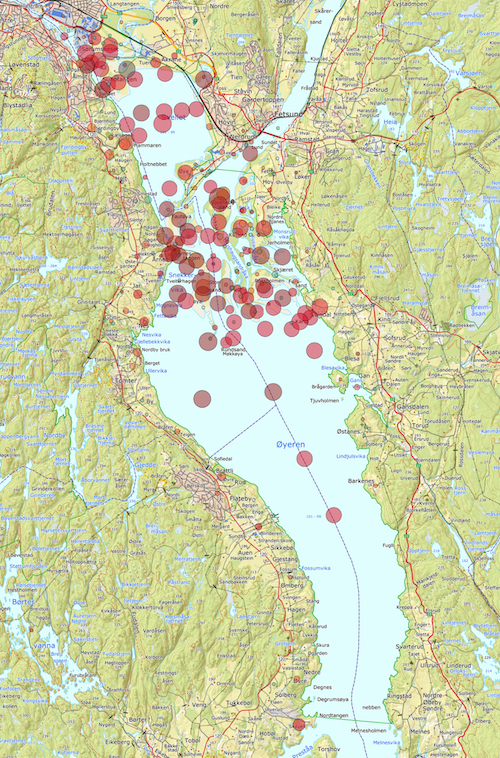A total of 9 data publication projects from 5 institutions were submitted for co-funding from the Norwegian GBIF node for this call. All the 9 projects submitted were found eligible for funding. However, only 5 projects were selected for co-funding because of the budget limit for the call. The GBIF Node has an annual budget of NOK 500 000 kr for these projects and received applications for in total NOK 735 000 kr co-funding this year.
We are very grateful for the assistance from the Swedish GBIF Node and Artsdatabanken with the evaluation of the submitted data-publication projects!
Project applications 2017:
University of Oslo, Natural History Museum in Oslo (1)
- Hymenoptera (wasps): Ichneumonoidae; families: Ichneumonidae and Braconidae.
- Insecta (small orders): Dermaptera (earwig), Blattodea (cockroaches), Orthoptera (grasshoppers, locusts and crickets), Raphidioptera (Snakeflies), Megaloptera (alderflies, dobsonflies, fishflies), Planipennia (lacewings), Mecoptera (scorpionflies) and Hemiptera (cicadas, aphids, planthoppers, leafhoppers, shield bugs).
Status per March 2019: work in progress.
University of Oslo, Natural History Museum in Oslo (2)
- Radiolaria and plankton in Norwegian waters.
Project participants: Kjell Bjørklund (NHM, University of Oslo) and Svetlana B. Kruglikova (P.P. Shirshov Institute of Oceanology, Russian Academy of Sciences).
A complete checklist was published of all Radiolaria species (191 taxa) found in Norwegian seas including visiting drift species. DOI:10.15468/rf5geo (191 taxa).
Occurrences with abundance estimates for Radiolaria in Norwegian seas calculated from sediment samples. DOI:10.15468/ruw305 (27 324 occurrences)
Nordre Øyeren Bird Observatory
- Bird observations from Nordre Øyeren and Sørumsneset nature reserve, 1980-1994.
- A total of 77 066 quality controlled bird species occurrences were published on the Norwegian Species Observation System (Artsobservasjoner).
- With these data points, the dataset NØF-Arkiv now includes 157 049 records and 84 409 data records from 1980 to 1994.



Norwegian University of Life Sciences (NMBU), Faculty of Environmental Sciences and Natural Resource Management
- Birds, mammals, insects, vascular plants, lichens, mosses and more. Many datasets.
Species occurrence data to be published in 2018 was estimated to around 90.000 data records. The final record of events counted 2,328,116 occurrences, from 13 data sets.
Project participants: Mari Steinert, Markus Sydenham, Anne Sverdrup-Thygeson, Vidar Selås, Katrine Eldegard, Stein R. Moe, and Tone Birkemoe at NMBU MINA.
Datasets published from MINA, NMBU, and available from GBIF.org:
- Lichens from a study of primary producer traits across an altitudinal gradient in alpine Finse. DOI:10.15468/asarqe (1 140 occurrences, 922 presence points).
- Saproxylic insects caught in window traps and hatched from polypores in small and large old forests in southern Norway. DOI:10.15468/0bgfrp (23 726 occurrences, 4 306 presence points).
- Lepidoptera collection, South Norway. DOI:10.15468/grazco (1 475 occurrences).
- Springtales from lichen communities at Kollåsen in Norway. DOI:10.15468/a13mrw (2 400 occurrences, 1170 presence points).
- Saproxylic and herbivorous beetle species in old near-natural and old managed forests in south-eastern Norway. DOI10.15468/o2kv85 (175 914 occurrences, 4306 presence points).
- Beetles in hollow oaks in Vestfold, Telemark and Agder collected with alcohol-baited traps. DOI:10.1002/ece3.4486 (4 970 occurrences, 4 970 presence points).
- Beetles on polypores at 4 sites in Norway. DOI:10.15468/zpvckz (140 occurrences, 50 presence points).
- Insects in monitoring oaks in Norway – a pilot study. DOI:10.15468/tgjl21 (15 730 occurrences, 382 presence points).
- Arthropod collections from Darbu. DOI:10.15468/ajts0r (to be implemented).
- Effects of vegetation clearing and dead wood on beetles in power line clearings southeast Norway. DOI:10.15468/rnxive (2 093 724 occurrences, 41 201 presence points).
- Bumblebees collected in a large-scale field experiment in power line clearings, southeast Norway. DOI:10.15468/6iunbi (5 016 occurrences, 1 257 presence points).
- Solitary bees collected in a large-scale field experiment in power line clearings, southeast Norway. DOI:10.15468/69el4c (3 131 occurrences, 3 131 presence points).
- Bryophytes from a study of primary producer traits across an altitudinal gradient in alpine Finse. DOI:10.15468/g28uix (750 occurrences, 187 presence points).
In total approximately 59 051 presence occurrence points.
University of Bergen, University Museum, Department for Natural History
- Coleoptera: Scolytinae (bark and wood-boring beetles).
- Diptera: Chironomidae (non-biting midges).
- Diptera: Syrphidae (hoverflies).
Occurrence data published in MUSIT, with the Entomology collection.
Norwegian University of Science and Technology (NTNU), University Museum in Trondheim
Digitize historical primary biodiversity data from the literature, Huitfeldt-Kaas, 1918, Atlas of freshwater fish in Norway.
- Huitfeldt Kaas: Freshwater fish distribution in Norway 1918 (50 605 occurrences)










